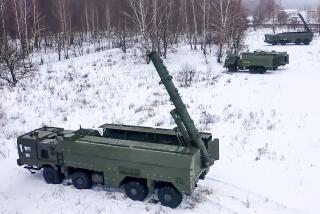War Strategy’s Lesson
- Share via
The assertion by the Navy’s top admiral that U.S. forces might try to destroy nuclear missile-bearing Soviet submarines on the outbreak of a conventional non-nuclear war is not especially surprising. But it’s a disturbing reminder of how difficult it would be to prevent any U.S.-Soviet conflict from escalating rapidly into nuclear war.
Planners at the North Atlantic Treaty Organization headquarters in Brussels believe that, if the Soviets ever launched a conventional non-nuclear invasion of Western Europe, one of their first targets would be the nuclear-tipped weapons that are on station in France, Great Britain and West Germany. The objective of such attacks would be to destroy the weapons before they could be used, leaving the military advantage in Europe clearly on the side of the Soviet Union. Soviet military writings also suggest that U.S. strategic submarines could be attacked in the early stages of a conventional war. It should surprise no one that U.S. military leaders think in similar terms. The problem is, however, that once one or both sides initiated attacks on elements of the other’s nuclear forces, a use-them-or-lose-them mentality could emerge, resulting in quick escalation to nuclear war.
As recently as November, Navy Secretary John F. Lehman Jr. said that it was “not necessarily” American policy to attack Soviet strategic submarines in a non-nuclear conflict. However, Adm. James D. Watkins, chief of naval operations, said otherwise in a recent article that was cleared for publication by Defense Secretary Caspar W. Weinberger.
Actually, each side is forced to assume the employment of pre-emptive attacks by the other, regardless of what is or is not said for publication. The real lesson is that, given the dangers of nuclear escalation, American and Soviet political leaders must do their utmost to manage big-power relationships in a way that will avoid a U.S.-Soviet conflict of any kind.
More to Read
Sign up for Essential California
The most important California stories and recommendations in your inbox every morning.
You may occasionally receive promotional content from the Los Angeles Times.













